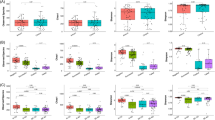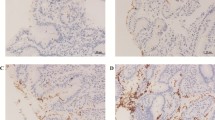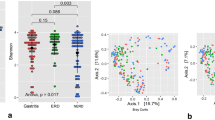Abstract
Our purpose was to use endoscopically directed biopsies and scanning electron microscopy to quantify Helicobacter pylori biofilm density on the surface of human gastric mucosa in urease-positive and -negative patients. Participating patients underwent flexible esophagogastroduodenoscopies coupled with gastric mucosal biopsies. Rapid urease testing was performed on all specimens to determine the presence of H. pylori, followed by scanning electron microscopy to identify the existence of biofilms. Samples were then analyzed using Carnoy Image Analysis Software to determine percent biofilm coverage of the total surface area. These data were compared to control specimens that were urease negative. Of the patients who tested urease positive for H. pylori, the average percent of total surface area covered by biofilms was 97.3%. Those testing negative had an average surface area coverage of only 1.64%. These differences were determined to be statistically significant at the 0.0001 level. This study demonstrates that compared with controls, urease-positive specimens have significant biofilm formation, whereas urease-negative specimens have little to none. This was reflected in the significantly increased biofilm surface density in urease positive specimens compared with urease-negative controls.
Similar content being viewed by others
References
Marshall BJ, Windsor HM. The relation of Helicobacter pylori to gastric adenocarcinoma and lymphoma: Pathophysiology, epidemiology, screening, clinical presentation, treatment, and prevention. Med Clin North Am 2005;89:313–344.
Meurer LN, Bower DJ. Management of Helicobacter pylori infection. Am Fam Physician 2002;65:1327–1336.
Godshall CJ. Treatment of Helicobacter pylori infection in patients with peptic ulcer disease. Am J Surg 2002;183:2–3.
Kearney DJ. Retreatment of Helicobacter pylori infection after initial treatment failure. Am J Gastroenterol 2001;96:1335–1339.
Davey ME, O’Toole GA. Microbial biofilms: From ecology to molecular genetics. Microbiol Mol Bio Rev 2000;64:847–867.
Costerton JW, Lewandowski Z, Caldwell DE, et al. Microbial biofilms. Annu Rev Microbiol 1995;49:711–736.
Watnick P, Kolter R. Biofilm, city of microbes. J Bacteriol 2000;182:2675–2679.
Cole SP, Harwood J, Lee R, She R, Guiney DG. Characterization of monospecies biofilm formation by Helicobacter pylori. J Bacteriol 2004;186:3124–3132.
Lewis K. Riddle of biofilm resistance. Antimicrob Agents Chemother 2001;45:999–1007.
Costerton JW, Stewart PS, Greenberg EP. Bacterial biofilms: A common cause of persistent infections. Science 1999;284:1318–1326.
Carron MA, Tran VR, Sugawa C, Coticchia JM. Identification of Helicobacter pylori biofilms in human gastric mucosa. J Gastrointest Surg. (in press).
Chole RA, Faddis BT. Evidence of microbial biofilms in cholesteatomas. Arch Otolaryngol Head Neck Surg 2002; 128:1129–1133.
Chole RA, Faddis BT. Anatomical evidence of microbial biofilms in tonsillar tissues: A possible mechanism to explain chronicity. Arch Otolaryngol Head Neck Surg 2003;129: 634–636.
Donlan RM. Biofilms: Microbial life on surfaces. Emerg Infect Dis 2002;8:881–890.
Nickel CJ, McLean RJC. Bacterial biofilms in urology. Infect Urol 1998;11:169–175.
Lucas CE, Sugawa C, Riddle J, et al. Natural history and surgical dilemma of “stress” gastric bleeding. Arch Surg 1971; 102:266–273.
Doherty GM, Way LW. Stomach and duodenum. In Way LW, Doherty GM, eds. Current Surgical Diagnosis and Treatment, 11th ed. New York: Lange Medical Books/McGraw-Hill, 2003, pp 533–564.
Stewart PS, Costerton JW. Antibiotic resistance of bacteria in biofilms. Lancet 2001;358:135–138.
Author information
Authors and Affiliations
Corresponding author
Additional information
Grant support was provided by FMRE Wayne State University School of Medicine, Department of Otolaryngology, Head and Neck Surgery.
Rights and permissions
About this article
Cite this article
Coticchia, J.M., Sugawa, C., Tran, V.R. et al. Presence and density of Helicobacter pylori biofilms in human gastric mucosa in patients with peptic ulcer disease. J Gastrointest Surg 10, 883–889 (2006). https://doi.org/10.1016/j.gassur.2005.12.009
Issue Date:
DOI: https://doi.org/10.1016/j.gassur.2005.12.009




